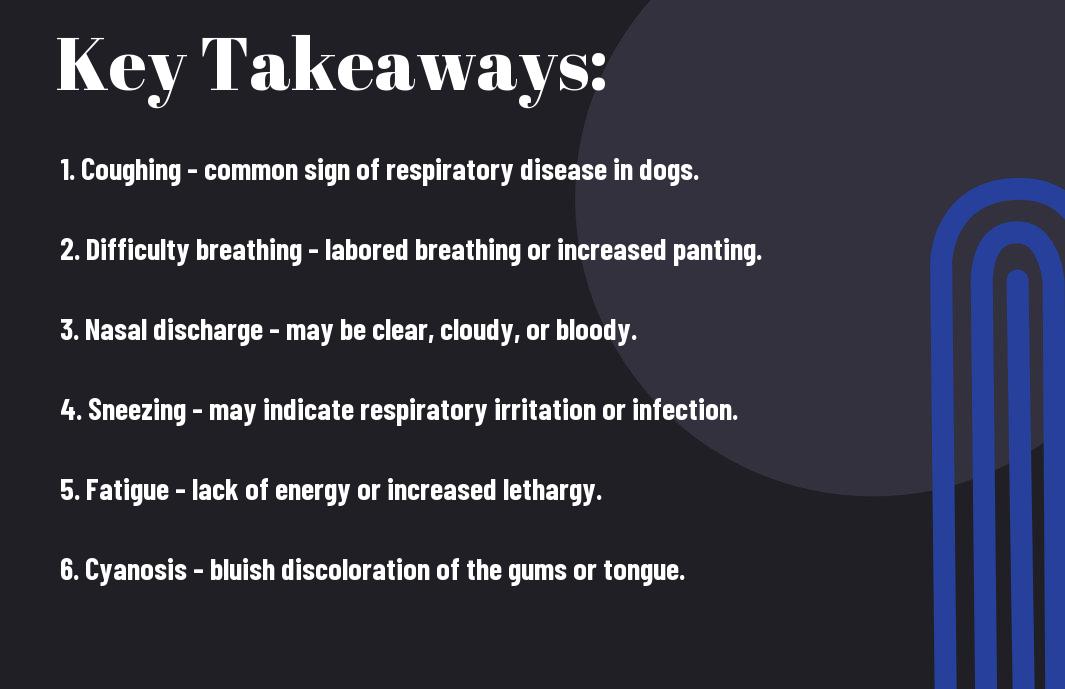Coughing, sneezing, wheezing, and labored breathing – these are just a few signs that your furry friend may be suffering from a respiratory disease. As an attentive pet parent, it is vital to recognize these symptoms early on to ensure your dog receives the necessary care and treatment. In this blog post, you will learn about the common signs of respiratory issues in dogs, helping you to promptly address any concerns and keep your beloved pup healthy and happy.
Key Takeaways:
- Coughing: Persistent coughing is a common symptom of respiratory disease in dogs. It can indicate issues such as infection, allergies, or heart disease.
- Difficulty Breathing: Labored breathing, rapid breathing, or wheezing are signs that your dog may be experiencing respiratory distress. This could be due to various underlying conditions like pneumonia or bronchitis.
- Nasal Discharge: If your dog has abnormal discharge from the nose, such as mucus or blood, it could be a sign of respiratory disease. This, along with other symptoms, should prompt a visit to the veterinarian for proper diagnosis and treatment.
Common Respiratory Symptoms in Dogs
A key indicator that your dog might be experiencing a respiratory disease is the presence of certain symptoms. Recognizing these signs early can help in getting timely care for your furry friend. Here are some common respiratory symptoms that you should watch out for:
Coughing and Sneezing
The most common sign of a respiratory issue in dogs is coughing and sneezing. Just like in humans, coughing in dogs can vary from a minor irritation to a severe, hacking cough. Sneezing can also be a sign of an underlying respiratory problem. If you notice your dog coughing or sneezing frequently, it’s imperative to consult your veterinarian for a proper diagnosis and treatment.
Difficulty Breathing
With respiratory diseases, your dog may also exhibit signs of difficulty breathing. Rapid breathing, shallow breaths, or even open-mouth breathing can indicate a problem. If you notice your dog struggling to catch their breath or showing any signs of respiratory distress, it’s crucial to seek immediate veterinary attention as these symptoms can be serious.
Difficulty breathing can be particularly concerning in dogs with flat faces (brachycephalic breeds) like Pugs or Bulldogs, as their anatomy already predisposes them to respiratory issues. Extra care should be taken with these breeds to ensure their environments are not exacerbating any breathing difficulties.
Wheezing and Panting
One more respiratory symptom to watch out for in your dog is wheezing and excessive panting. Wheezing is characterized by a high-pitched whistling sound when your dog exhales, which can indicate a constriction in the airways. Excessive panting, especially when your dog hasn’t been exerting themselves, could also point to an issue. If you observe these symptoms, it’s imperative to have your dog evaluated by a veterinarian to determine the underlying cause.
Respiratory diseases in dogs can vary in severity, from mild allergies to more serious conditions like pneumonia or bronchitis. Being attentive to these common respiratory symptoms and seeking prompt veterinary care can help in managing your dog’s respiratory health effectively.
Upper Respiratory Tract Symptoms
Nasal Discharge and Congestion
One of the main symptoms of respiratory disease in dogs is nasal discharge and congestion. Any changes in your dog’s normal breathing patterns or the appearance of a runny or thick discharge from their nose should be closely monitored. This could indicate an infection or inflammation in the upper respiratory tract.
Redness and Swelling of the Eyes
One common sign of respiratory issues in dogs is redness and swelling of the eyes. Discharge from the eyes, such as pus or mucus, may also be present. These symptoms can accompany nasal discharge and are often indicative of a more severe respiratory infection.
This eye discharge can be clear, cloudy, yellow, or green. It is important to pay attention to the color and consistency of the discharge as it can provide valuable information to your veterinarian about the underlying cause of the respiratory condition.
Loss of Appetite and Depression
One of the less obvious signs of respiratory disease in dogs is a loss of appetite and depression. Discharge from the eyes and nose, along with difficulty breathing, can make your dog feel uncomfortable and lead to a decrease in appetite. Your dog may also seem more lethargic or disinterested in their usual activities.
Depression and lack of interest in food or play can be early indicators that something is wrong with your dog’s respiratory health. If you notice these changes in behavior, it is necessary to consult with your veterinarian for a thorough evaluation and appropriate treatment.
Lower Respiratory Tract Symptoms
Coughing Up Blood or Yellow Mucus
To identify lower respiratory tract symptoms in your dog, pay attention if you notice your furry friend coughing up blood or yellow mucus. This can indicate a more serious underlying issue that requires veterinary attention. If you observe this symptom, it’s imperative to consult your veterinarian promptly to determine the cause and provide appropriate treatment.
Rapid Breathing Rate
Any sudden increase in your dog’s breathing rate can be a sign of lower respiratory tract problems. If you notice your dog breathing rapidly even while at rest, it could indicate issues such as pneumonia, bronchitis, or other respiratory conditions. Monitoring your dog’s breathing patterns can help you detect changes early and seek veterinary care if necessary.
Breathing is an imperative indicator of your dog’s respiratory health. A normal breathing rate for a dog at rest is typically between 10-30 breaths per minute. If you observe a consistently elevated breathing rate in your dog, it’s crucial to have them evaluated by a veterinarian to rule out any respiratory issues.
Lethargy and Fatigue
For lower respiratory tract symptoms, lethargy and fatigue can be common indicators. If your usually energetic dog seems unusually tired, uninterested in activities, or reluctant to exercise, it’s imperative to consider the possibility of respiratory problems. These symptoms can accompany conditions like pneumonia, bronchitis, or even lung cancer, so prompt veterinary evaluation is vital.
Rate. Share any concerning changes in your dog’s energy levels with your veterinarian, as this information can aid in diagnosing and treating potential respiratory diseases effectively. Keeping an eye on your dog’s overall behavior and well-being can help you catch any respiratory issues early and help your furry companion get back to their happy, healthy self.
Chronic Respiratory Symptoms
Persistent Coughing
After noticing symptoms of respiratory disease in your dog, you may observe persistent coughing as a chronic respiratory symptom. Any ongoing cough that lasts for more than a few days should not be ignored. It can be a sign of an underlying issue that needs to be addressed by your veterinarian.
Recurring Infections
On occasion, your dog may experience recurring respiratory infections as a chronic symptom. Any repeated episodes of respiratory infections, such as bronchitis or pneumonia, could indicate a more serious condition that requires medical attention. It is crucial to monitor your dog’s health and seek veterinary care if these infections persist.
Persistent respiratory infections can weaken your dog’s immune system and overall health. This can lead to more frequent and severe bouts of illness, impacting their quality of life. Therefore, it is crucial to address these recurring infections promptly with the help of your veterinarian.
Weight Loss and Poor Condition
With chronic respiratory disease, you may notice weight loss and a decline in your dog’s overall condition. Persistent respiratory symptoms can make it challenging for your dog to eat, breathe, and maintain their energy levels. If you observe these signs, it is crucial to seek veterinary advice to address the underlying respiratory issue.
To help your dog regain their health and well-being, your veterinarian may recommend a tailored treatment plan that includes medications, dietary changes, and possible lifestyle adjustments. By addressing the respiratory symptoms and supporting your dog’s recovery, you can improve their quality of life and ensure they thrive despite their condition.
Acute Respiratory Symptoms
Unlike chronic respiratory diseases that develop over time, acute respiratory symptoms in dogs present suddenly and require immediate attention. These symptoms can be alarming and may indicate a serious underlying issue that needs prompt veterinary evaluation.
Sudden Onset of Coughing or Difficulty Breathing
An abrupt onset of coughing or difficulty breathing in your dog can be a sign of acute respiratory distress. This can be a red flag for conditions such as pneumonia, bronchitis, or even an obstructed airway. If you notice your dog struggling to catch its breath or experiencing persistent coughing fits, seek veterinary care immediately.
Blue-tinged Lips or Gums
Gums that appear blue-tinged in color, along with bluish lips, are concerning signs that your dog is not getting enough oxygen. This could be due to poor lung function, heart problems, or another serious issue affecting oxygen exchange in the body.
For instance, a condition like pneumonia can lead to a decreased ability to oxygenate the blood, resulting in a bluish tint to the mucous membranes. If you observe this in your dog, do not delay in seeking veterinary attention.
Severe Lethargy and Collapse
One of the severe respiratory symptoms in dogs is profound lethargy and sudden collapse. If your dog is extremely weak, unable to stand, or collapses, it could be a sign of critical respiratory failure. This requires immediate medical intervention to determine the cause and provide appropriate treatment.
Sudden onset of severe lethargy and collapse is a medical emergency, and you should not hesitate to seek urgent veterinary care for your dog. Delay in treatment can worsen the condition and jeopardize your dog’s health and well-being.
Other Signs and Indicators
Despite the more common symptoms of respiratory disease in dogs, there are other signs and indicators you should be aware of that may signal a problem.
Changes in Vocalization or Barking
Barking: If you notice changes in your dog’s vocalization patterns or if they are barking more than usual, it could be a sign of respiratory distress. Dogs may vocalize differently when they are experiencing discomfort or difficulty breathing, so pay attention to any changes in their barking behavior.
Increased Heart Rate
Changes: An increased heart rate can also be a potential indicator of respiratory disease in dogs. If you notice your dog’s heart rate is elevated without a clear reason like exercise or excitement, it could indicate an underlying respiratory issue that needs to be addressed.
Heart: Monitoring your dog’s heart rate along with their breathing patterns can provide valuable insights into their respiratory health and overall well-being. If you suspect respiratory disease based on an elevated heart rate, it’s necessary to consult your veterinarian for further evaluation and treatment.
Pale Gums or Lining of the Ears
Changes: Pale gums or a paler lining of the ears than usual can be a significant indication of respiratory distress in dogs. These changes in mucous membrane color can suggest a lack of oxygen circulating in the body, which may be linked to respiratory problems.
Ears: Observing the color of your dog’s gums and the lining of their ears regularly can help you detect any potential issues early on. If you notice paleness or any other concerning changes, it’s crucial to seek veterinary attention promptly to address any respiratory issues that may be affecting your dog’s health.
Final Words
Following this overview of the symptoms of respiratory disease in dogs, it is important to remember that your furry friend relies on you to pay close attention to any signs of breathing difficulties. Regular check-ups with your veterinarian, maintaining a healthy lifestyle for your pet, and being aware of any changes in their breathing patterns can help you catch potential respiratory issues early on. Keep in mind, early detection and treatment are key to ensuring your dog’s respiratory health and overall well-being.
FAQ
Q: What are the symptoms of respiratory disease in dogs?
A: Symptoms of respiratory disease in dogs may include coughing, wheezing, difficulty breathing, nasal discharge, rapid breathing, and exercise intolerance.
Q: How can I tell if my dog is having trouble breathing?
A: Watch for signs such as extended neck and head, flared nostrils, blue gums, increased respiratory effort, and noisy breathing, which may indicate your dog is having trouble breathing.
Q: When should I seek veterinary care for my dog’s respiratory symptoms?
A: It is important to seek veterinary care if your dog is experiencing persistent or severe respiratory symptoms, as respiratory diseases can be serious and require medical attention.
Q: What are some common causes of respiratory disease in dogs?
A: Common causes of respiratory disease in dogs include infections (bacterial, viral, or fungal), allergies, foreign objects lodged in the airway, heart disease, and tumors.
Q: How can I help prevent respiratory diseases in my dog?
A: To help prevent respiratory diseases in dogs, avoid exposing your dog to smoke, pollution, and other respiratory irritants, keep your dog up to date on vaccinations, maintain a healthy weight, and provide regular exercise.
Are strawberries toxic for dogs
Your Dog’s Allergies: Expert Advice
Demystifying Anal Gland Issues in Dogs: Your Comprehensive Guide from the American Kennel Club




